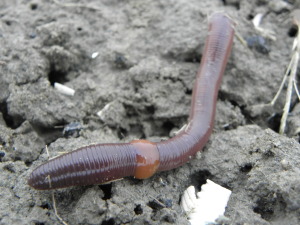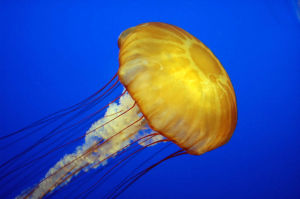Fluid Support of the Hydrostatic Skeleton

Spineless Doesn't Mean No Support
Have you ever heard the words: "You're spineless?" While meant as an insult, it's actually a compliment in biological terms. You probably already know that some animals, like humans, have internal skeletons (endoskeletons), and some have external skeletons (exoskeletons), like insects. But the story doesn't end there, nature is much more complex and diverse. There is an entire class of organisms that has a type of skeleton, called a hydrostatic skeleton. It is just like the name implies, a static skeleton made of fluid (hydro).

Hydrostatic skeletons rely on fluid (mostly water) that is always under pressure. This is because there is a a constant volume of fluid in an enclosed body space called the coelom or coelomic cavity. The fluid in the coelomic cavity resists compression, providing structure to the animal. Hydrostatic skeletons occur mostly in invertebrates like worms, the polyps (aquatic larvae) of some invertebrates, sea anemones, jellyfish, and other Cnidarians (jellyfish-like creatures).
Hydrostatic support is also found in the organs of many types of animals. Humans use hydrostatic fluid to support their tongue movement, starfish use hydrostatic support to move their hundreds of fluid filled tube-feet, squid and octopus us hydrostatic support to move their arms and legs, and many vertebrates like turtles and elephants have hydraulic/hydrostatic penises (spring loaded fluid filled chambers are much easier for a 2 ton elephant than climbing on top of his poor mate's back). Some invertebrates, like crabs and lobsters, switch between hard exoskeletons to a temporary hydrostatic skeleton when they molt, and while they are waiting to harden. This type of fluid pressurization gives them at least partial movement if they need to flee from predators while their shells are soft.

The key to all hydrostatic skeletons, and hydrostatic appendages, is that the shape of their body/appendage is cylindrical, with the body space being filled with fluid that can move around. This type of body/appendage plan is kind of a tube in a tube, or pretty much a tube of fluid surrounded by a tube of muscle.
So if a creature is filled with fluid how do they manage to not collapse like a sack of jelly, and how do they move about? Animals with hydrostatic skeletons rely on muscles to provide structure and support as well as movement. As you know, muscle fibers do not stretch on their own. In hydrostatic skeletons, muscles require an antagonistic system of contraction and relaxation by moving fluid around. Think of it sort of like when you squeeze a water balloon and the water moves from one end to the other, stretching the balloon's skin. Something similar happens in the bodies of animals with hydrostatic skeletons.
There are five main types of muscle arrangement combinations that help the animals move their fluid around, thus moving their muscles:
1. Muscles that ring the body cavity.

Earthworms are a great example of this muscle configuration. They belong to the phylum Annelid meaning literally "little rings." Their muscles form little rings around their coelomic cavity. Their body plan is kind of a tube in a tube, a tube of fluid surrounded by a tube of muscle.
2. Muscles that radiate out from the center of the body cavity, like a wagon wheel.

Sea anemones have this near the top of their heads, where their arms radiate out (so do squid and cuttlefish). Animals with full-body hydrostatic skeletons most often show radial symmetry. This means that if you can divide their body in many mirror like pieces (like spokes of a wagon wheel), unlike humans who can only be divided into two mirror-like halves.
3. Muscles that run longitudinally.
An animal must be able to contract muscles longitudinally so that it can move forward and back. This is why it also has muscles that run the length of the body or tube. The same is true for appendages like tube feet or tongues.
4. Spiraled or Criss-crossed muscle arrangement.
Many animals also have muscle fibers that are criss-crossed or in a spiral.. These arrangements provide strength and stability, as well as the ability to bend and torque the body.
Movement for animals with hydrostatic skeletons is all about elongation and contraction of muscles using the movement of body fluids. Whether it's the trunk of an elephant, the tentacle of a squid, or the movement of an earthworm it's all about fluid pressure. If you'd like to know more, check out this research paper from the Journal of Experimental Biology and William Kier. I would also suggest that you check out your local aquarium (especially in the winter when it's cold) to view sea anemones and other inverts that have these amazing types of support structures. Earthworms are also easy to observe. Next time you see one on the sidewalk take a moment to see if you can observe the vertical and horizontal muscle contractions of their body and how that relates to forward or backward momentum and fluid movement. It's quite fascinating once you know what to look for. You can also use small water balloons to demonstrate this idea to students or visitors on a trail hike or in a classroom.
Hydrostatic skeletons are also a fun way to integrate biology with a discussion about engineering and design. I enjoy teaching hydraulics and movement of simple machines using water. There's a great lesson plan online by "Instructables." https://www.instructables.com/id/Easy-Hydraulic-Machines/.


